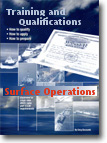Return to Division 6's Home Page.
Qualifications - Boat Crew (Boat Crew Training - BCT)
The award ribbon for earning this qualification has yellow and blue vertical stripes:
This ribbon recognizes qualifications in the various operations program areas. Auxiliarists who qualify as an Auxiliary crew member, air observer, AtoN verifier, Coast Guard watchstander, Coast Guard boat crewman, or Coast Guard boat engineer may wear the Operations Program Ribbon. Watchstanders and boat engineers are defined as Auxiliarists who have been designated in writing by a Coast Guard unit, or the Director, as qualified in that position. Auxiliarists show multiple qualifications by adding 3/16-inch bronze or silver stars. The “E” device is authorized to be worn on the Auxiliary Operations Program ribbon by Auxiliarists who are currently appointed, or have been appointed, as a QE. No miniature “E” device for miniature medals is authorized.
CG Station Miami Beach is the operationally most active CG station in the nation. Station Miami Beach responds to over 300+ calls a year.
Division 6 has a legacy of excellence in its operational service to Station Miami Beach. LCDR Michael Cortese has left a strong relationship to his successor. Lieutenant Raymond Heberlig is currently serving as the Commanding Officer of Coast Guard Station Miami Beach, Florida, where he oversees all boating safety, security, law enforcement and Search and Rescue Operations for the greater Miami Region.
Station
Miami Beach is increasingly assigning meaningful missions to us. We
support marine patrols, search and rescue, and training missions for
them including boarding exercises, helicopter training we serve as
escorts for the USCG Cutter Eagle and other vessels; we set up security
cordons to assist with CG operations, Land Sea Air Shows, regattas. We
are called out for environmental pollution incidents, boating and
aircraft mishaps and a myriad of other operational activities.
PROCESS: To qualify as Crew, first speak with your Mentor and your Flotilla Staff Officer Operations (FSO-OPS). Then sign up with the FSO-MT. You will be enrolled in the Boat Crew Training Program over the course of the next year and undertake an intensive reading course, participation in land and underway training classes, and other BCT opportunities.
Boat Crew Manuals:
OTW EVOLUTIONS & COMMANDS TRAINING GUIDE
The Auxiliary Boat Crew Qualification Guides are an integral part of the boat crew qualification and certification process. Each volume contains a collection of tasks which must be learned, practiced, and performed by the trainee. These tasks represent the minimum elements of skill and knowledge necessary for safe and effective performance as a Coast Guard Auxiliary boat crew member.
Other Auxiliary Training and Qualification Guides and Manuals
QUALIFICATION: To qualify, you must successfully test on all land tasks and on the water training evolutions. Once you have completed the training, you will be tested by a Qualifications Examiner (QE) and upon passing, would become qualified Crew. At that point, you may crew for coxswains as qualified crew and are no longer classified a trainee.
Task Verification in PQS Notebook
Documentation Packet
Oral Board
Practical Test (QE)
UNIFORM: You will need your ODU and the summer variation of the uniform, including boat shoes. Once you have your ODU and boat shoes, you will be invited to participate in our patrols as a trainee.
REPORTING: Remember to report your hours as defined in the Form 7029 as soon as you complete the activity. FSO-IS Mario Gutierrez can assist you with any questions.
Hint: Don't always wait to be invited out on a boat. Take every opportunity to get out on our flotilla's vessels, whatever the mission. Get hands on experience. It is a good idea to crew for as many different coxswains and on different facilities as possible to increase your skill level by practicing constantly.
